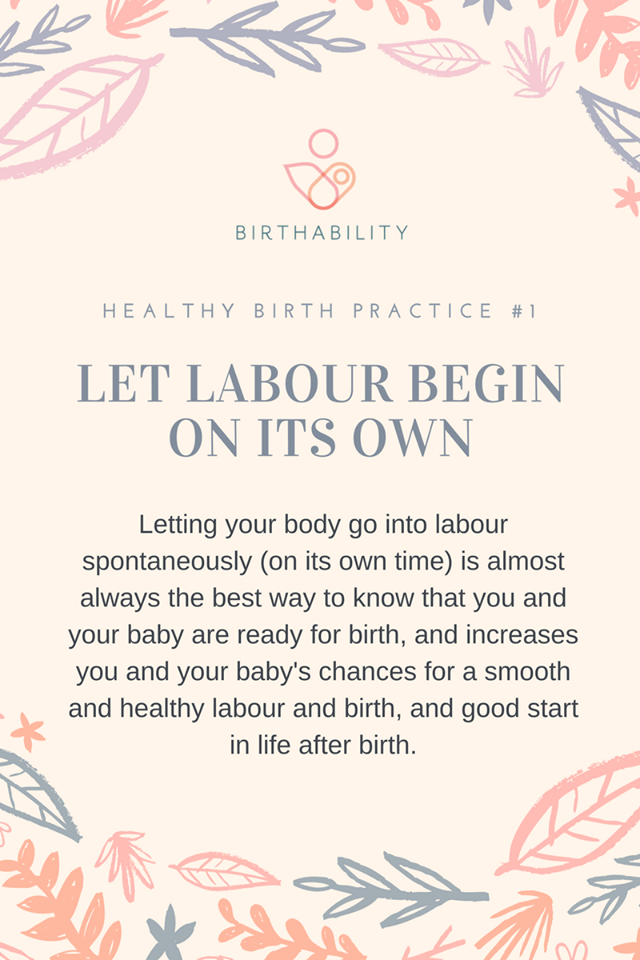
BIRTHABILITY BLOG
Everything birth
Healthy Birth Practices # 1
Let labour Begin On It's Own.
Letting your body go into labour spontaneously is almost always the best way to know that your baby is ready to be born and that your body is ready for labour. In the vast majority of pregnancies, labour will start only when all the players—your baby, your uterus, your hormones, and your placenta—are ready.
Let labour Begin On It's Own.
Last week I introduced you all to The Lamaze 6 Healthy Birth Practices, each and everyone is important in the role of Labour and Birth and can help improve outcomes for mother and baby.
For many women, the last days and weeks of pregnancy can be very uncomfortable and emotionally difficult. We are anxious to meet our babies and hold them in our arms. Aches and pains may become more bothersome. Sometimes, minor problems or worries arise,and mothers may feel pressure to induce their labour—even when it would be safer to wait.
Letting your body go into labour spontaneously is almost always the best way to know that your baby is ready to be born and that your body is ready for labour. In the vast majority of pregnancies, labour will start only when all the players—your baby, your uterus, your hormones, and your placenta—are ready. Naturally, labour usually goes better and mother and baby usually end up healthier when all systems are go for birth. Every day of the last weeks of pregnancy is vital to your baby's and body's preparation for birth.
If your labour is induced (started artificially), it becomes a medical event and proceeds quite differently from spontaneous labour.
It’s important to remember that induction is forcing labour to begin before the baby and mother’s body are ready.
Let Labour Start on Its Own - Here's How:
• Know that your "due" date is not an expiration date. Only about 5 percent of moms give birth on their due date. Instead of a day, think of it as your due "month."
• Take a childbirth education class such as Birthability's, Learn how to have a safe, normal and healthy labour, learn about induction and informed decision making.
• If your care provider suggests an induction, ask questions. Is it an emergency? What's the risk in waiting? What are the alternatives?
• Hire a doula who can provide resources and information on labour and local care providers and birthplaces.
• Remind yourself that every day your baby is still on the inside is one more day she needs to grow and develop.
• If you end up needing an induction, learn how you can keep your labour as normal and healthy as possible.
The Lamaze Healthy Birth Practices
The Lamaze Healthy Birth Practices
Lamaze today is a ‘philosophy’ of birth, founded on 6 Healthy Birth Practices that are designed to encourage women to trust their bodies, reduce fear, and have a healthy and safe birth for mother and baby.
The Lamaze Healthy Birth Practices
The Lamaze 6 Healthy Birth Practices, have you heard of them?
Years ago Lamaze became widely known as a ‘method’ for birth, teaching a breathing and coping style that came to be known by its name.
Lamaze today is a ‘philosophy’ of birth, founded on 6 Healthy Birth Practices that are designed to encourage women to trust their bodies, reduce fear, and have a healthy and safe birth for mother and baby.
The Lamaze Healthy Birth Practices are the foundation of Lamaze. These Birth Practices are designed based on years of research to help simplify the birth process with an informed approach that helps alleviate fears and manage pain. Regardless of baby’s size, your labor’s length and complexity, or your confidence level, these care practices will help keep labor and your baby's birth as safe and healthy as possible.
It's a Date
Its a Date!
The humble Medjool date it seems may just have some hidden superpowers!
A study conducted in 2011 and published in the Journal of Obstetrics and Gynecology, has some really interesting results from comparing two groups of women: those who consumed..........
It's a Date!
The humble Medjool date it seems may just have some hidden superpowers!
A study conducted in 2011 and published in the Journal of Obstetrics and Gynecology, has some really interesting results from comparing two groups of women: those who consumed six dates per day in the last four weeks of labour and those who did not.
Here are a few interesting results from the study:
- Spontaneous labour occurred in 96% of those who consumed dates, compared with 79% women in the non-date consumers.
- Use of prostin/oxytocin was significantly lower in women who consumed dates (28%), compared with the non-date consumers (47%).
- The mean latent phase of the first stage of labour was shorter in women who consumed dates compared with the non-date consumers. (Those who consumed dates had an average 8.5 hours of first stage labor while those who didn’t had an average 15.1 hours of first stage labor.)
- The women who consumed dates had significantly higher mean cervical dilatation upon admission compared with the non-date consumers.
The study concluded that the consumption of dates in the last 4 weeks before labour, significantly reduced the need for induction and augmentation of labour, and produced a more favorable, delivery outcome.
https://www.ncbi.nlm.nih.gov/pubmed/21280989
The effect of late pregnancy consumption of date fruit on labour and delivery. - PubMed - NCBI
J Obstet Gynaecol. 2011;31(1):29-31. doi: 10.3109/01443615.2010.522267.
NCBI.NLM.NIH.GOV|BY AL-KURAN O , ET AL.






